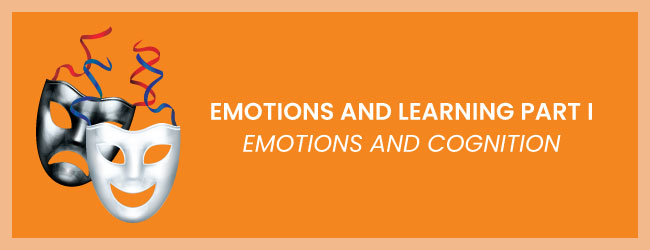
I’ve never done a formal survey, but I’m going to guess that the majority of our online courses don’t have a strong emotional impact on the audience. This is true even though it’s been known for some time that there is a connection between emotions and learning. Appealing to the emotions is one of the keys to motivating people, attracting their attention and facilitating memory.
I have to admit, I don’t always consider the emotional dimension of my audience either. But I sense that if we were better able to recognize and speak to a learner’s emotions, it would help us escape the rigid design mindset that often prevails in our community. This is the first in a three-part series about this topic.
Emotion and Cognition
The idea that emotion and cognition are opposing phenomena comes from a long philosophical and scientific tradition. At one time, scientists thought that if emotions were connected to feelings and bodily sensations then they must be quite separate from cognition, which was associated with logic and the mind.
Now sophisticated imaging tools like the fMRI have demonstrated the error in this thinking. We now know that emotion and cognition are dynamically intertwined in terms of both neurology and psychology. Emotion and cognition not only interact, but their integration is necessary for adaptive learning. See The Influence of Emotions on Learning and Memory for research in this area.
The Amygdala and All That
Researchers consider the amygdala to be the primary component involved in emotional memory. The amygdala is an almond shaped brain structure packed with neurons, shown in this graphic (in red). Each half of the brain has one of these 1-inch long structures—not too far from the ear—thought to be part of the limbic system, which regulates emotion.
Of interest to learning design is that activation of the amygdala correlates with greater retention of information. In other words, increased emotional arousal following a learning event influences the strength of the memory for the event.
This makes sense in terms of survival. It’s important to remember the fearful and rewarding events in order to protect and enhance your life.
Emotions Are Our Alert System
Cognitive scientists define emotions as powerful, usually short-lived experiences that are a reaction to a specific stimulus. As part of the human evolutionary legacy, emotions arise from a rapid appraisal of an object or event’s significance in order to prepare us for action—similar to an alert system.
Emotions not only increase our general awareness and help us adapt to changes in an unpredictable environment, but they also facilitate social communication and interaction. That’s because we read the emotions of others through their facial expressions, bodily postures, gestures and tone of voice.
Related to this is the concept of feelings, which are the subjective experience of emotions. Whereas emotions relate to survival, feelings do not. Researchers measure emotions through brain imaging, skin temperature, heart rate and blood pressure. Feelings are currently difficult to measure.
Rapid Decision-making
Researchers think that emotions bypass the cognitive processes involved in decision-making. When we make decisions using cognitive processes, we evaluate and analyze the costs and benefits of an action. On the other hand, emotional decision-making relies on “rule-of-thumb” concepts and approximations. Thus, emotions allow us to make rapid evaluations. We exert less mental effort when making decisions with emotions. That’s why advertisers prefer to appeal to the emotions.
We can take advantage of a person’s emotional capacity in order to enhance learning. Read about it in Emotions and Learning: Part II.
Related Articles:
Emotions and Learning: Part II
10 Ways To Design For Emotions Part III
Books You May Like:
Emotional Design: Why We Love (or Hate) Everyday Things
The Emotional Brain: The Mysterious Underpinnings of Emotional Life


great way of putting it. Thanks
Thanks for your comment, Mary. I think your idea of using a single message or call to action is a unique perspective for eLearning.
Great article. The best e-learning efforts speak to the emotional dimension and have a single message or call to action.